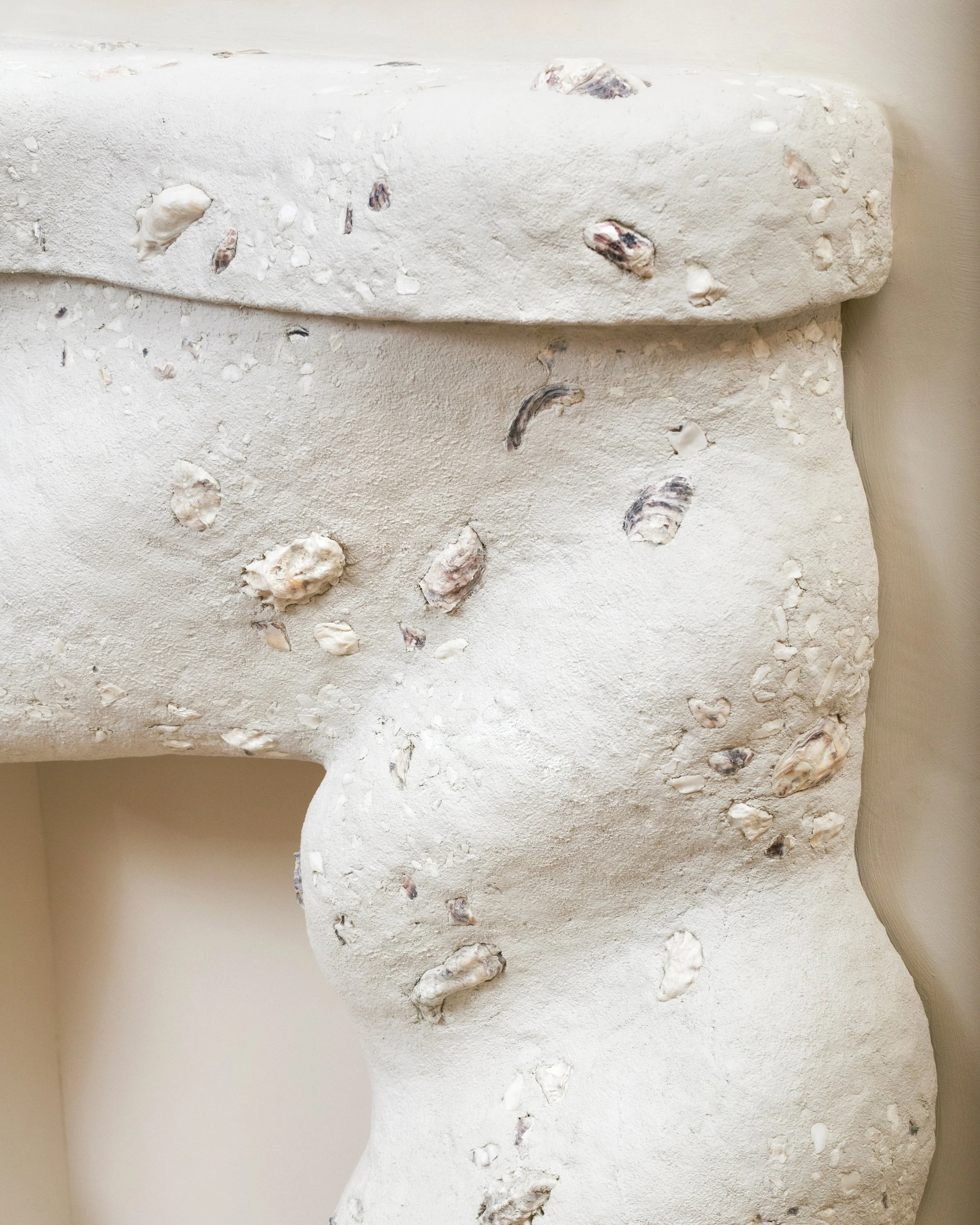Tabby Fireplace
Project, Materials

Diptyque Paris is known for their world-class scents, as well as their commitment to shining a light on the skills of artists and craftspeople. For their newly opened store in Vancouver, Diptyque commissioned Franklin St. Studio to provide an expression of local materials in the creation of a custom fireplace, a centrepiece that highlights the area’s relationship to the sea. Supported by Diptyque, our studio was able to undertake material research of historical lime plasters integrated with oyster shells collected from the shores of Fanny Bay to emulate a traditional tabby concrete. Through much experimentation and collaboration, the project culminated in our studio designing and fabricating a unique undulating fireplace with a traditional lime plaster surface rendering.
Lime is one of the oldest building materials, its use dating to at least 10,000 years ago and spanning all corners of the globe. Found in Egyptian pyramids, within the walls of Machu Picchu, and adorning the ornate facades of Mayan ruins, lime plasters have a rich history of cultural and economic importance owing to their simple and abundant material inputs. While the ratios and recipes vary by culture, the base constituents - fire, water, and a calcium carbonate source (CaCO₃), remain integral. In many coastal areas that calcium carbonate source was the ubiquitous oyster shell. Lime plasters composed of burnt shells, crushed shell aggregate, and water, are referred to as a “tabby” concrete, an unsung material which required community cooperation and a depth of knowledge to produce, and laid the material foundation for many of today’s modern societies.
Lime plaster facade from the site of Chiccaná, Mexico (Alonso, 2010)
The process of converting oyster shells to plaster occurs in 3 stages called the Lime Cycle. The shells are heated to 900°C to create a quicklime powder, releasing CO₂ in the process. Once the quicklime is rehydrated, the CO₂ is reabsorbed and then the plaster sets, returning to a solid calcium carbonate and continuing to absorb CO₂ over its lifespan. A delicate balance of water, plaster, and aggregate is needed, and a diligence in controlling the plaster’s drying rate as it sets over several days. Cultures around the world historically modified the lime’s properties with local additives to suit regional environments. In China, the addition of sticky rice, a polysaccharide, altered the carbonate crystals to be more compact, stronger, and flexible. Acids detected in Mayan lime plasters increased their resistance to heat and humidity. British mortars were said to contain beer, wine, and blood. Most of the organic additives were used as strength and property enhancers, but there is very little use of them in modern lime applications.
Franklin St. Studio experimented with drying rates, shell fragment size and application, and natural traditional additives to achieve the desired structure and aesthetic. Goat hair was embedded during the first application of the plaster, creating a mesh of spiky fibers that locked together within the plaster for extra tensile strength over the compound curves of the form. Marble dust, a fine powder of quartz, was added to the final coat fill in small openings, preventing fissures. Oyster shells collected in Fanny Bay were cleaned and broken down, and integrated into the plaster as it was applied. Once the plaster had sufficiently cured was coated in a natural limewash.
Tabby concrete reached North America through Spanish conquistadores, with its adoption and popularity dependent on the labour and material mastery afforded by enslaved black people. Following the Civil War, lime plaster fell out of favour due to the arduous multi-staged production process, which also coincided with the rise of the now ubiquitous Portland Cement. While lime plaster use today is mostly limited to restoration work, its environmental credentials are fueling a resurgence in interest. Lime plasters reabsorb approximately 25% of the CO₂ emitted during its curing process, while cement reabsorbs none. Lime allows masonry to breathe, preventing mold and poor indoor air quality. And lime-based materials can be easily recycled for use as aggregate, fertilizer, water purification and more. The widespread use of lime throughout history and spanning the globe serves as a testament to it versatility and staying power. While today’s societies favour efficiency and simplicity, lime plaster represents a return to materials that are slower, require knowledge sharing and build in community cooperation in their creation. From the addition of local inputs that structurally alter the plaster to suit, to the surface level of application styles and aggregate types used, to build with lime plaster is to build with people, place and intention in mind.
-
Photography
-
(Some) References
Aquiline, J. F. (n.d.). About Lime The Historic and Sustainable Mortar and Plaster Binder. Retrieved 11 29, 2024, from Limeworks.
Carran, D., Hughes, J. J., & Kennedy, C. (2012). A Short History of the Use of Lime as a Building Material Beyond Europe and North America. International Journal of Architectural Heritage, 117-146.
Idowu, J. (2024). Tapia, Tabbi, Tabique, Tabby. Places Journal, 1-17.
Limeworks. (n.d.). About Lime: The Historic and Sustainable Mortar and Plaster Binder. Retrieved 12 01, 2024, from Limeworks.









